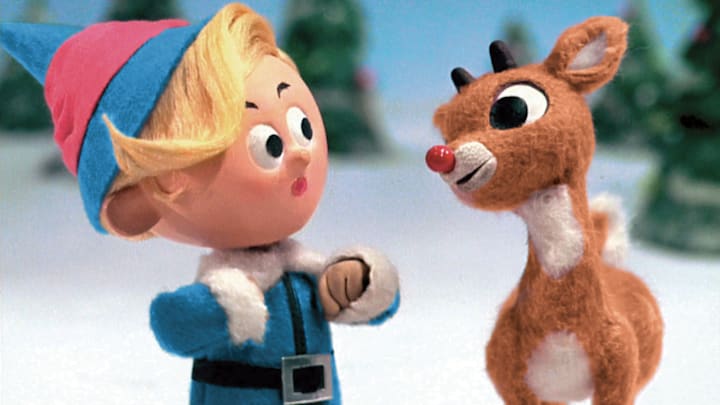The folklore surrounding Christmas doesn’t benefit from scrutiny. Tales of an Arctic workshop run by elves, a flying sled, and a jolly man who slides down chimneys after gorging on cookies are best paired with a strong suspension of disbelief. Compared to these stories, the taxonomy of Rudolph may seem trivial. But certain animal lovers can’t let go of the question: Why is the red-nosed reindeer so often depicted as a white-tailed deer?
Table Of Contents
All of the Other Reindeer
The flying animals that pull Santa Claus’s sled are officially reindeer, which makes sense within the broader mythology. Santa and his elves reside at the North Pole, and reindeer (known as caribou in North America) are found on lands above the Arctic Circle. They’ve also been used to pull sleighs across Scandinavia and Siberia for millennia (though not necessarily the toy-filled kind).

Reindeer are members of the deer family, but several features set them apart from their white-tailed cousins found in the Americas at lower latitudes. They have broad, furry snouts rather than black, button noses; their wider hooves are adapted for padding over snow. Members of both sexes also sport bulky antlers for part of the year. Female reindeer lose their antlers in the summer and males shed them in the winter, which implies that Santa’s reindeer are either all girls or too young to grow the head ornaments.
The Most Famous Reindeer of All
When depicting flying reindeer in story books and animated specials, artists rarely aim for scientific accuracy. The original 12 reindeer debuted in the 1823 poem “A Visit from Saint Nicholas” (better known as “The Night Before Christmas”), and Rudolph appeared over a century later. A booklet distributed by the Chicago department store Montgomery Ward in 1939 introduced the story of the red-nosed reindeer and showed him looking rather un-reindeer like. He was given the slight build and tiny hooves of deer found at more southerly latitudes. The resemblance to white-tailed deer is even more pronounced in Rudolph’s peers, who all have tiny black noses.
When Montgomery Ward copywriter Robert May created the character, he didn’t set out to confuse generations of children about what reindeer look like. His daughter Barbara was fond of the deer at the Lincoln Park Zoo, so he sent an artist there to model the story book characters on the resident deer. Though the final design resembles a common white-tailed deer, the inspiration may have been a more exotic species: Chital, or axis, deer are native to India, and a chital fawn had been born at the Lincoln Park Zoo the year before “Rudolph the Red-Nosed Reindeer” was published. Like white-tailed deer, the animals also have small, black noses and tiny hooves.
You’ll Go Down in History
The Montgomery Ward booklet may have invented Rudolph the Red-Nosed Reindeer, but many people’s perception of the Christmas character comes from the 1964 animated television special of the same name. If you picture Rudolph as a fawn with two stubby antlers, a brown tail with a white underside, and a small snout with a glowing red nose at the end, Rankin/Bass may be why.
“The Rankin/Bass TV special is 100 percent of how people think of Rudolph the Red-Nosed Reindeer today,” Rick Goldschmidt, author of Rudolph The Red-Nosed Reindeer: The Making Of The Rankin/Bass Holiday Classic, tells Mental Floss.

Writer Romeo Muller and designer Antony Peters took inspiration from the Robert May booklet while making the characters their own. Because they were building a world for stop-motion animation, simplicity was a priority.
“Antony Peters was a minimalist,” Goldschmidt says. “In animation, you need to be—this is why some hands were animated with three fingers. The idea is to keep things simple.” To film the show, technicians moved the models of Rudolph and his pals a tiny bit and shot the scene, moved them another tiny bit, shot the scene, and so on. The technique was dubbed Animagic.
The petite features of white-tailed deer translated smoothly to this style of animation. Instead of figuring out how to make a reindeer’s broad snout glow red, the animators gave Rudolph a small snout with a round, red nose at the end where the other reindeer had small black ones.
“The reindeer were perfect in Rudolph. In later Rankin/Bass productions, they did give the reindeer longer snouts and, in general, the appearance was a little more detailed. But I don't like it as much as the earlier stuff that Tony designed,” Goldschmidt says.
Holiday media has since dabbled in more accurate representations of reindeer. The 1989 film Prancer, 1994’s The Santa Clause, and 2003’s Elf all show the magical versions of the creatures as they appear in nature. But when Rudolph shows up in movies and shows today, he still maintains the white-tailed deer look popularized by the Montgomery Ward book and the Rankin/Bass cartoon. It’s a testament to the effectiveness of the original designs—but it the difficulty of putting a red nose on a reindeer without making it look like a clown may also be a factor.
